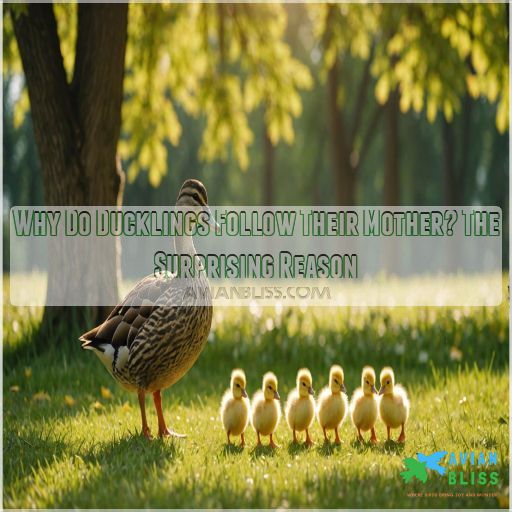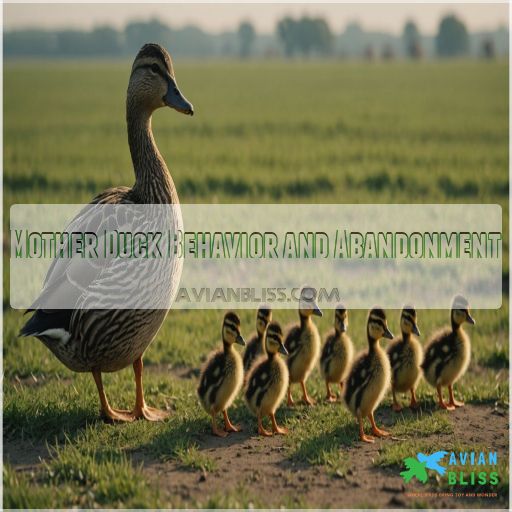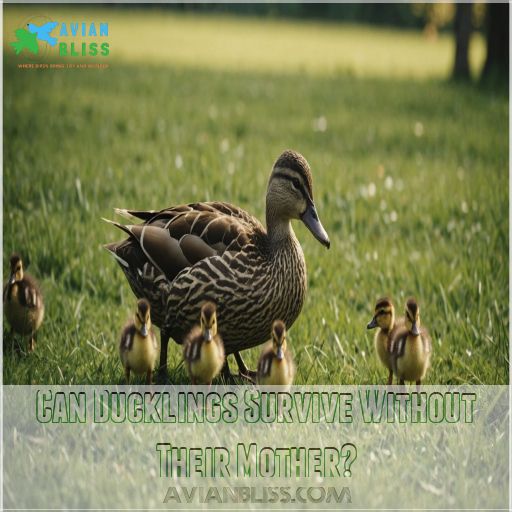This site is supported by our readers. We may earn a commission, at no cost to you, if you purchase through links.

Following her keeps them safe from predators and teaches them essential survival skills like foraging and communicating. Plus, they conserve energy by staying in a neat line behind her. Imagine it as a little parade, where protection and learning go hand in hand.
Curious about how this family dynamic, which involves imprinting and learning from their mother, helps in more ways than you think?
Table Of Contents
- Key Takeaways
- Instinctual Imprinting
- Importance of Motherly Bond
- Ducklings’ Dependence on Mother
- Mother Duck Behavior and Abandonment
- Caring for Abandoned Ducklings
- Can Ducklings Survive Without Their Mother?
- Age of Independence for Ducklings
- Mother Duck’s Protective Instincts
- Why Do Ducklings Follow Their Mother?
- Ducklings’ Development and Growth
- Frequently Asked Questions (FAQs)
- Why do ducklings ‘duck’?
- Why do ducklings follow their mother?
- Do ducklings follow you?
- Why do baby ducklings imprint?
- Why do ducks follow their mom?
- What makes a duckling follow its mother?
- How long do ducklings follow their mother?
- What does it mean when a duckling follows you?
- What happens if a duckling gets separated?
- Do ducklings respond to other animals calls?
- How do ducklings find food with their mother?
- Are there specific hiding behaviors in ducklings?
- Can other ducks adopt orphaned ducklings?
- Conclusion
Key Takeaways
- You’re witnessing nature’s GPS in action when ducklings follow their mom. It’s not just adorable – it’s a survival strategy called imprinting that helps these fluffy navigators learn essential life skills.
- Imagine stepping into a new world where the first thing you see becomes your everything. That’s imprinting for ducklings. They’re hardwired to bond with the first moving object they see (usually mom), creating a mental template that guides their behavior.
- Mom’s not just a tour guide – she’s a bodyguard, chef, and teacher all rolled into one. By following her, ducklings learn to forage, avoid predators, and regulate their body temperature. It’s like a crash course in "How to Duck 101."
- You might think ducklings are stuck to mom like glue forever, but they’re actually prepping for independence. Over about 50-60 days, they gradually spread their wings (literally and figuratively), developing unique personalities and self-reliance.
Instinctual Imprinting
When you watch a brood of ducklings following their mother, you might wonder what drives this behavior.
The answer lies in instinctual imprinting, a rapid and irreversible learning process that creates a mental template of the mother’s characteristics, like physical features, movements, and vocalizations.
This mental template helps the ducklings recognize her and form a strong bond for survival.
The process of rapid and irreversible learning is key to understanding this behavior.
Survival Instinct
When you think about ducklings following their mother, you might wonder what drives this behavior. The answer lies in instinctual imprinting, a process discovered by Konrad Lorenz in 1935.
- Duckling vulnerability: Newly hatched ducklings are defenseless and rely on their mother for protection.
- Predator avoidance: By following their mother, ducklings reduce their risk of predation and mortality.
- Line formation: Ducklings form a line behind their mother, conserving energy and staying safe.
- Survival strategies: This imprinting process helps ducklings learn essential survival skills from their mother.
Learning to Forage
You’ve likely noticed your ducklings are naturally curious about their surroundings, and it’s time to encourage their foraging skills.
By gradually reducing food availability, you’ll prompt them to search for food sources on their own.
This process helps them develop important survival skills, such as finding edible plants and insects, under their mother’s guidance.
Communication and Social Bond
As a duckling, you’re drawn to movement and sound, instinctively imprinting on the first being you encounter, usually your mother.
This initial bond sparks a lifelong connection, with duckling communication relying on vocalizations and social cues to navigate the flock.
Family dynamics are key, as ducklings thrive in a social environment with a strong social bond.
Thermoregulation
Ducklings’ ability to regulate their body temperature, or thermoregulation, is essential to their survival.
To keep warm, they exhibit huddling behavior, relying on their mother’s body heat and feather insulation.
Nest temperature also plays a significant role in duckling thermoregulation (Source).
By staying warm, ducklings reduce their risk of cold stress and promote overall health and safety.
Predation Avoidance
In terms of staying safe, ducklings have a lot to learn.
To avoid predators, they follow their mother’s lead, adopting a line formation that increases visibility and reduces vulnerability . This strategy also helps conserve energy, as they can draft off each other while foraging.
Key benefits include:
- Improved communication signals
- Enhanced flock cohesion
- Reduced predation risk
Importance of Motherly Bond
As you watch a mother duck lead her brood, you might wonder what drives these tiny creatures to follow her so closely.
The answer lies in the importance of the motherly bond, which is essential for the ducklings’ survival and development.
It teaches them essential skills like foraging, predator avoidance, and thermoregulation.
Physical Characteristics and Vocalizations
To understand why ducklings follow their mother, consider their physical characteristics and vocalizations. Research has shown that ducklings learn to recognize their mother’s call before hatching.
| Vocalization | Meaning | Example |
|---|---|---|
| High-pitched peeping | Distress or hunger | A series of rapid, high-pitched peeps |
| Quacking | Communication and social bonding | A low, soothing quack |
| Raehb-raehb-raehb | Alarm or warning | A loud, repetitive call |
| Maternal call | Assembly and guidance | A soft, clucking sound |
Environmental Stimuli and Recognition
You’ve probably noticed that ducklings follow their mother’s visual cues, maternal calls, and even olfactory signals. But did you know they also learn to recognize their mother’s environment?
- Nest imprinting: Ducklings learn to recognize their hatching location.
- Maternal calls: They distinguish their mother’s voice from others.
- Environmental exploration: They get familiar with their surroundings through observation and experience.
Learning Essential Survival Skills
The remarkable bond between a mother duck and her ducklings is important for their survival.
By following their mother, ducklings learn essential skills like foraging techniques, predator avoidance strategies, and communication methods.
This instinctual imprinting, which occurs within 24-48 hours of hatching, helps the ducklings’ survival and development in the wild.
Safety in Numbers and Reduced Predation Risk
As ducklings master important survival skills, they learn that sticking together is key to staying safe.
By following their mother, they benefit from the "safety in numbers" principle, where collective vigilance and group cohesion reduce predation risk.
This flock defense strategy helps vulnerable ducklings, like muscovy and wood ducklings, avoid predators using flock defense strategy.
Ducklings’ Dependence on Mother
As you watch a brood of ducklings following their mother, have you ever wondered why they’re so dependent on her?
From providing warmth and food to teaching them essential survival skills, the mother duck plays a key role in her ducklings’ development.
Understanding this dependence can offer valuable insights into their behavior and biology.
Provision of Warmth, Food, and Protection
Following their mother is a matter of life and death for ducklings.
- Warmth: Ducklings need their mother’s down feathers to stay warm, especially in cold climates.
- Food: Although they can peck at the ground for food, mother ducks provide guidance on what’s edible.
- Protection: Mother ducks shield their ducklings from predators and other dangers.
- Safety: Ducklings are vulnerable to predators and temperature fluctuations without their mother’s care.
Learning to Swim, Forage, and Avoid Danger
Within hours of hatching, ducklings are swimming and foraging with their mother’s guidance . She teaches them predator defense, foraging techniques, and water safety, essential for their survival.
By following their mother, ducklings learn valuable skills, such as how to find food, avoid danger, and navigate their environment. This process allows them to acquire essential skills for their survival and growth.
Inability to Survive Alone in the Wild
Imagine a duckling lost in the wild, shivering and alone.
Without their mother, they’re extremely vulnerable to predation risk, environmental threats, and survival challenges.
Orphaned ducklings struggle to survive, with most not making it past a day or two.
Their dependence on mother is essential for warmth, food, and protection.
Specialized Care and Attention Required
Ducklings need special care and attention to survive.
As you raise your ducklings, remember to provide a safe and warm environment, with adequate space for rest and exploration.
A balanced diet, suitable for their nutritional needs, is also essential, along with proper handling techniques to prevent disease.
Mother Duck Behavior and Abandonment
As you watch a mother duck care for her ducklings, you might wonder what drives her behavior and what happens if she abandons them.
Mother ducks may leave their nest due to various reasons such as distance from a water source, predators, inexperience, or unforeseen circumstances.
Understanding these factors can provide insight into their behavior and the importance of their role in their ducklings’ lives, and the importance of their role helps illustrate how mother ducks are crucial to their ducklings’ survival and development.
Leaving the Nest Due to Distance From Water
As you watch a mother duck care for her brood, you might wonder why she’d leave the nest due to distance from water.
It’s simple: water access is vital for duckling survival . A nest too far from water can be a death sentence, so mother ducks instinctively relocate to guarantee their babies’ safety and survival.
Abandonment Due to Predators or Inexperience
You’ve probably witnessed a mother duck panic and abandon her ducklings when sensing predators or feeling overwhelmed by her inexperience . This behavior is more common than you think.
- Predator response: Mother ducks will flee to protect themselves, leaving their ducklings behind.
- Inexperienced mothers: First-time mothers may not know how to care for their ducklings, leading to abandonment.
- Human intervention: Well-meaning humans may inadvertently scare mother ducks away from their ducklings.
- Environmental factors: Harsh weather or lack of food can cause mother ducks to abandon their ducklings.
Unforeseen Circumstances and Forced Abandonment
In some cases, a mother duck may be forced to abandon her ducklings due to unforeseen circumstances like extreme weather, environmental hazards, or human intervention.
This can be a stressful experience for the mother and her babies, leading to duckling vulnerability and potential harm.
Grief and Loss of Ducklings
When a mother duck loses her ducklings, she experiences intense grief, often becoming withdrawn and silent, like a duck with wet feathers
. This emotional response is a coping mechanism, helping her deal with the loss.
- Changes in behavior, such as reduced foraging and social interaction.
- Vocalizations, like quacking or whining, to express distress.
- Physical changes, such as a decrease in appetite or sleep disturbances.
- Withdrawal from their usual environment, seeking solitude.
Caring for Abandoned Ducklings
If you’ve ever come across abandoned ducklings, you know how helpless they can seem without their mother’s care.
As a caregiver, you’ll need to provide a safe, warm environment, a suitable space for rest and exploration.
A balanced diet is also essential for their survival.
Even a companion can make a big difference in reducing stress and give them their best chance at survival.
Providing a Safe and Warm Environment
If you’re caring for abandoned ducklings, prioritize creating a safe and warm environment.
A mother duck’s brood can thrive without a heat lamp if she’s able to keep them close . Make sure the space is well-insulated, and consider using materials like pine shavings to maintain a comfortable temperature and protect from environmental hazards (Source).
Suitable Space for Rest and Exploration
You’ve created a safe and warm environment for your abandoned ducklings, now it’s time to think about space for rest and exploration.
A suitable enclosure should mimic their natural habitat.
Consider these key elements:
- Duckling enclosure design with enough space to move around
- Nest box alternatives, like a warm and cozy shelter
- Safe play areas, both indoors and outdoors
- Enrichment toys to stimulate their natural behaviors
- A balance between freedom and protection for good growth and development
Feeding a Balanced Diet
Now that you’ve set up a suitable space for your ducklings, it’s time to think about their nutritional needs.
To make sure they get a healthy start, provide a balanced diet rich in protein, vitamins, and minerals. A starter mix specifically formulated for ducklings is a great option.
| Nutrient | Requirement |
|---|---|
| Protein | 18-20% |
| Calcium | 1-2% |
| Phosphorus | 0.5-1% |
| Vitamin A | 10,000 IU/kg |
Providing a Companion to Reduce Stress
When caring for abandoned ducklings, providing a companion can greatly reduce stress, promoting socialization and emotional well-being.
As ducks are intelligent and social animals , they thrive in groups, reducing feelings of loneliness and depression.
By keeping two or more ducks together, you’re creating a supportive environment that fosters companionship and stress reduction.
Can Ducklings Survive Without Their Mother?
You might be wondering if ducklings can survive on their own if they get separated from their mother.
The answer is that it’s extremely challenging for them without her care. Without their mother’s warmth, food, and protection, ducklings are highly vulnerable to predators and temperature fluctuations.
They can only survive for about a day or two if they’re kept warm and fed, highlighting their dependence on maternal care for survival.
Vulnerability to Predators and Temperature
Without their mother, ducklings are extremely vulnerable to predators and temperature fluctuations.
- Ducklings rely on their mother’s brooding to regulate their body temperature.
- Without her, they’re at risk of hypothermia or overheating.
- Predator adaptations, such as camouflage and hiding, are essential for survival.
- Mother duck cues, like vocalizations and visual signals, help ducklings avoid danger
.
- Huddling behavior can provide some protection, but it’s not enough on its own.
Limited Timeframe for Survival Without Mother
Your duckling’s survival chances are slim without its mother’s care.
Generally, a baby duck will only survive alone for a day or two.
Orphaned ducklings face numerous survival challenges, including predators and harsh weather conditions.
Their mother’s role is essential in providing warmth, food, and protection, making her absence a significant threat to their survival.
Importance of Consistent Temperature and Food
Now that you know a duckling’s survival time without its mother is limited, let’s focus on what they need to survive.
Consistent temperature and food are absolutely necessary. Ducklings are vulnerable to hypothermia, and their nutritional needs must be met to prevent starvation.
Providing a safe, warm environment with suitable food sources is key to their survival, such as a diet consisting of high-protein duckling food, which includes a mix of small insects, mealworms, and finely chopped vegetables.
Age of Independence for Ducklings
As you watch ducklings follow their mother, you might wonder when they’ll become independent and strike out on their own.
Typically, ducklings stay with their mother for around 50-60 days, during which time they learn essential survival skills.
They develop a strong bond with her, eventually growing into capable young ducks.
These young ducks can fend for themselves.
Precocial and Altricial Species Comparison
Regarding ducklings’ age of independence, their precocial nature plays a significant role. Unlike altricial species, precocial ducklings are relatively mature and mobile from birth, with well-developed vision, motor skills, and general awareness.
- Early mobility: Precocial ducklings can walk and swim within hours of hatching.
- Self-feeding: They can feed themselves shortly after birth, with some guidance from their mother.
- Thermoregulation: Precocial ducklings can regulate their body temperature, reducing their reliance on their mother for warmth.
- Survival rates: Precocial species tend to have higher survival rates due to their increased independence and ability to fend for themselves.
Gradual Independence and Protection
As ducklings mature, they gradually gain independence, learning to forage, swim, and avoid predators on their own.
| Age | Milestone | Independence Level |
|---|---|---|
| 1-2 weeks | Thermoregulation, swimming | Low |
| 2-4 weeks | Foraging, predator avoidance | Medium |
| 4-6 weeks | Sibling interactions, brood size impact | High |
| 6-8 weeks | Solo foraging, predator adaptation | Very High |
By 5 weeks, ducklings are almost fully independent, but still benefit from motherly protection.
Guidance and Learning From Mother
By around three weeks of age, ducklings develop distinct personalities, frequently asserting their independence. However, they still need guidance from their mother.
Under her watchful eye, they develop critical skills like foraging, predator avoidance, and social interaction, gradually becoming more independent and self-sufficient.
Mother Duck’s Protective Instincts
When you see a mother duck leading her brood, you’re witnessing a powerful display of protective instincts.
As the vulnerable ducklings follow closely behind, they’re relying on their mother’s aggressive defense, shelter, and guidance to keep them safe from predators and help them survive.
Aggressive Defense and Keeping the Brood Close
You’ve probably seen a mother duck fiercely defending her brood from predators, and it’s not just a coincidence.
Mother ducks have an innate aggressive defense mechanism to keep their ducklings close and safe.
This natural instinct helps protect the brood from predator threats, ensuring their survival and fostering a strong flock cohesion.
Providing Shelter and Safety
A mother duck’s instincts are on high alert when it comes to protecting her ducklings. To provide shelter and safety, she’ll often lead them to a safe location, such as a nest or a body of water.
- Choosing a safe nest location, often with dense vegetation or a hidden entrance.
- Keeping a watchful eye out for predators, such as hawks or foxes.
- Teaching her ducklings safe foraging habits, like avoiding areas with high predator activity.
- Using her body to shield her ducklings from harm, such as inclement weather or predators.
Reducing Predation Risk and Ensuring Survival
As you watch a mother duck lead her brood, you might wonder how she keeps them safe.
It’s not just about shelter – it’s about reducing predation risk. Her presence deters predators, and her aggressive defense keeps the brood close.
| Predator | Duckling Defense |
|---|---|
| Hawks, owls | Stay close to mother, avoid open areas |
| Herons, crows | Use group defense, make noise to scare away |
| Snakes, foxes | Stay near water, use mother’s aggressive defense |
| Humans | Avoid areas with human activity, stay hidden |
Why Do Ducklings Follow Their Mother?
You’ve probably watched a mother duck and her brood waddling along, the ducklings following closely behind, and wondered, what makes them do that.
As it turns out, it’s not just a cute quirk – it’s a key survival strategy, driven by a process called imprinting.
Where the ducklings learn to recognize and trust their mother, and follow her for protection, food, and warmth.
Imprinting and Mental Template Creation
Ever wondered why ducklings follow their mother? It’s due to imprinting, a critical process that occurs during early developmental stages.
Imprinting creates a mental template in the duckling’s brain, helping them recognize and bond with their caregiver.
This phenomenon isn’t exclusive to ducks; other animals, like chickens, also exhibit species-typical behaviors shaped by their environment and genetics.
The critical period for imprinting is short, but its impact on memory and behavior is lasting.
Trust and Communication With Mother
You’re witnessing a remarkable display of trust and communication as ducklings follow their mother.
Through vocalizations and visual cues, the mother duck establishes a strong bond with her brood, teaching them essential survival skills.
This innate trust is built on the mother’s ability to provide warmth, food, and protection, allowing the ducklings to grow and thrive.
As they grow, they learn to recognize and respond to their mother’s signals, ensuring their safety and survival.
Ducklings’ Development and Growth
As you watch ducklings grow and develop, it’s clear that their early days are essential for forming strong bonds with their mother and learning essential survival skills.
From social bonding and communication to thermoregulation and environmental adaptation, ducklings undergo a remarkable transformation.
Understanding their development can provide valuable insights into their behavior and essential survival skills.
Social Bonding and Communication
Ducklings’ social bonding and communication play a key role in their development. They imprint on their mother, learning essential skills like vocalizations and social hierarchy within the family unit.
This bonding is evident in their:
- Vocalizations, such as peeping and chirping, to communicate with their mother
- Recognition of their mother’s calls, even in a crowded environment
- Ability to sense their mother’s emotions and respond accordingly
- Inclination to follow their mother’s lead, ensuring their safety and survival
Learning to Forage and Avoid Danger
While bonding through quacks establishes trust, learning to forage and avoid danger comes next.
You’ll see ducklings mimicking their mother, mastering foraging techniques by pecking at insects.
Predator identification is a survival skill she teaches by leading them away from threats. Mother duck teaches valuable lessons, and their communication skills develop with each lesson, ensuring these fluffy explorers are prepped for life’s hurdles, learning to avoid danger.
Thermoregulation and Environmental Adaptation
Imagine little ducklings waddling behind their mother, learning to stay warm like they’re cuddling under a cozy blanket.
This instinctive behavior isn’t just adorable—it’s essential for duckling survival. Ducks need temperature regulation to face environmental challenges, especially with climate change looming large.
Following mom helps them develop those key skills while providing some serious survival strategies .
Gradual Independence and Maturity
As ducklings adapt to their environment, you’ll see them gradually spreading their wings—both literally and figuratively.
They’re like awkward teens, gaining independence while honing foraging skills and predator awareness through sibling interactions and flock integration.
This playful process allows them to mature, with each quack and waddle sculpting their unique personalities and boosting their self-reliance.
Frequently Asked Questions (FAQs)
Why do ducklings ‘duck’?
Ducklings "duck" or dive underwater to explore, play, or escape predators.
It’s a natural behavior that enhances their survival skills, like learning to avoid danger.
Sometimes, they’re just playing around, practicing their future life skills .
Why do ducklings follow their mother?
You’ve probably seen ducklings swimming in a line behind their mother – but why do they do that?
It’s because they’re imprinting, or forming a bond, with the first moving object they see, usually mom.
Do ducklings follow you?
If you’re around during their early days, ducklings might see you as their mother and follow you everywhere.
This bonding period is brief, so make sure you’re in their sights and spend plenty of time with them.
Why do baby ducklings imprint?
Baby ducks imprint because it makes sure of their survival. Seeing shapes, sounds, and siblings swiftly secures their safety.
They’re like little GPS devices; their first sight or sound is what they consider "home."
Without their mom, they’ll attach to anything that moves, becoming like family.
Why do ducks follow their mom?
Ducklings tag along with their mom due to imprinting, where they identify her as the primary guide shortly after hatching.
This bond helps them receive protection, warmth, and even energy efficiency when swimming in her wake.
What makes a duckling follow its mother?
Imagine stepping into a new world, and the first thing you see is "Mom."
That’s what ducklings do – they imprint on their mother, ensuring safety and warmth.
It’s nature’s instinct keeping them securely connected and protected.
How long do ducklings follow their mother?
You’ve watched ducklings grow, and now you’re wondering when they’ll leave mom. Typically, ducklings follow their mother for 50-60 days before they fledge and become independent.
What does it mean when a duckling follows you?
Tiny webbed feet pitter-patter behind you.
It’s imprinting in action! The duckling’s brain has wired you as its mother figure.
You’re now its safety blanket, teacher, and family for life.
Quack-tastic responsibility, eh?
What happens if a duckling gets separated?
Separated ducklings face a tough road. They can’t survive without mom’s protection and guidance (Source).
If you spot a lone duckling, wait nearby – mom might return within 30 minutes. If she doesn’t, call wildlife rescue for help.
Do ducklings respond to other animals calls?
Ducklings can respond to various sounds, not just their mother’s call.
They’re wired to imprint on movement and sounds, potentially following other animals or even objects.
It’s nature’s way of ensuring they stick with their flock for safety.
How do ducklings find food with their mother?
Mother ducks: nature’s GPS for feathered foodies!
You’ll watch these waddling wonders dip and dive, teaching their fluffy followers the art of aquatic dining.
They’ll model food-finding behaviors, turning puddles into all-you-can-eat buffets for their devoted ducklings.
Are there specific hiding behaviors in ducklings?
You’ll notice ducklings have a knack for hiding.
They’ll nestle under mom’s wings or duck into vegetation when danger lurks.
It’s their built-in survival instinct, keeping them safe from predators while they’re still fluffy and vulnerable.
Can other ducks adopt orphaned ducklings?
Nature’s maternal instinct can surprise us. While rare, some adult ducks might take orphaned ducklings under their wing.
It’s not a sure bet, though. Wild ducks often reject or even harm non-biological offspring .
Proceed with caution and expert guidance.
Conclusion
Like a well-choreographed dance, the bond between mother ducks and their ducklings is a marvel of nature.
You’ve seen why ducklings follow their mother: it’s a mix of instinct, survival, and learning. This behavior isn’t just cute; it’s essential for their development and safety.
Next time you spot a duck family, remember the complex dynamics at play. From imprinting to foraging lessons, every waddle teaches these little ones key life skills.
It’s a reminder of nature’s intricate design and the power of family bonds.












